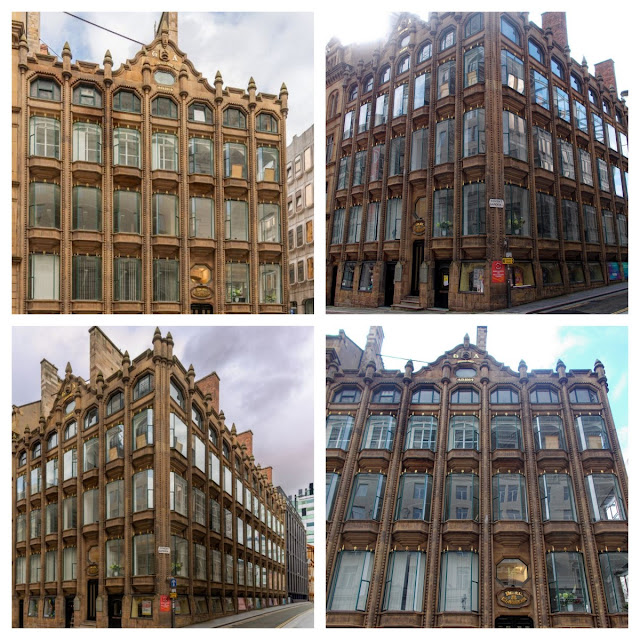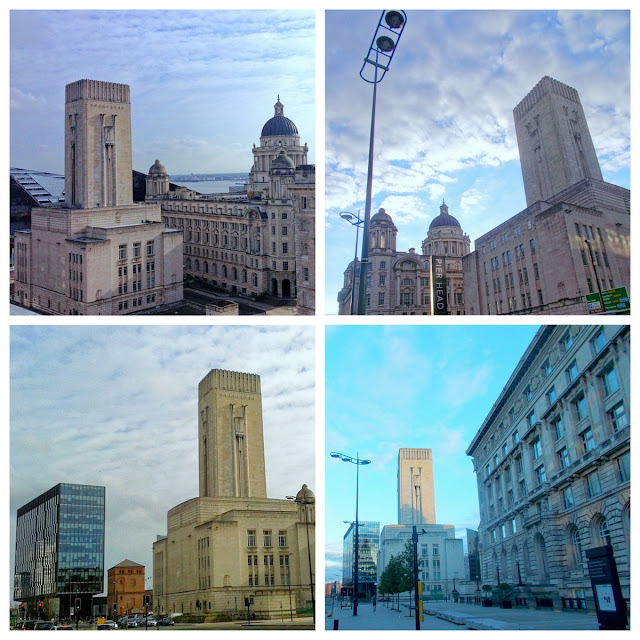Liverpool Landmarks Tour (Part Two)
Continuing our walk just check where you are on the map...
We are passing St John Gardens, landscaped from a former cemetery with grand memorial statues.
You may want to peep towards Queensway Tunnel, regarded as one of the great engineering feats. At the time of its opening in 1934, it was the longest underwater tunnel in the world.
Just notice two statues overlooking the tunnel entrance, one is to Queen Mary and the other is to King George V. There were massive crowds at the opening, you me see the photos in many Liverpool pubs and other places.
A scene from Harry Potter and the Deathly Hallows - Part 1 was filmed in the tunnel, with Hagrid and Harry on a flying motorbike or something. Also the chase scene for Fast & Furious 6 was shot here. Locals say it is haunted - many have seen a woman's ghost on a motorbike, or an old fashioned 1960's police car has been seen driving in the tunnel. Perhaps it act like a time travel portal, and truly it is - we always feel a bit strange driving through it. It has an eerie feeling.
Going down Whitechapel you will meet lovely corner building. This is now the Shankly Hotel. Football is a bloodstream in Liverpool as you probably know. The hotel is dedicated to Liverpool FC famous manager Bill Shankly (1913-1981).
Going down Whitechapel you will meet lovely corner building. This is now the Shankly Hotel. Football is a bloodstream in Liverpool as you probably know. The hotel is dedicated to Liverpool FC famous manager Bill Shankly (1913-1981).
There is also museum inside dedicated to the football icon, a bar and a sports themed restaurant, and rooftop garden. You may find here some alive football legends, both past and present, if you're lucky and want to step inside.
Whitechapel and Paradise Street follow the course of an original stream, which widened out into a muddy ('lifer' in Old English) tidal inlet known as Pool. So walking along those you may feel you are in the very centre of origins of Liverpool.
It was the eastern boundary of the town until the end of 17th century. The stream was covered over in 1725, and the town moved eastwards. This is where and when this tiny dwelling was transforming into a global city.
As a part of global fashion in the late 1960s - mid 1970s, Liverpool got his revolving restaurant, as every global decent city had. The mechanisms of those marvels eventually broke down everywhere and they have been adapted for different purposes. Here is a local radio station with transmitter - so it serves its noble purpose. You can also visit the tower for a small charge and wide horizontal view.
It is called Radio City Tower or St John's Beacon. The tower was opened by Queen Elizabeth II in 1969 and it is one of the modern important landmarks of the city.
Walking past Metquarter, a high-end shopping and leisure centre is the entrance to Cavern Quarter and Matthew Street, world-famous because of The Beatles, the band that shook the world's music.
White Star pub - the name derives from Liverpool's glorious past as a port - is one of the most cosy and loveliest pubs in this area. White Star was one of the biggest shipping companies in the world, headquartered in Liverpool waterfront and it built the famous Titanic. There are some memorabilia regarding this, on the walls.
Of course, this pub is also connected to The Beatles. They used to be paid here, after their performances in the Cavern Club, down the alley.
There are many more pubs and clubs, all modern in their stories, loosely referring to the past.
The Grapes pub is worth noticing. Here the Beatles helped themselves down with a pint or two, between their gigs, because the Cavern was an alcohol-free zone. Imagine this nowadays! The Grapes was the only one traditional pub on Mathew Street at the time. Nowadays it is a quasi shrine to the Beatles fans.
Magical Beatles Museum - created by Pete Best's step-brother. Pete Best was the drummer during the formative years of the band, replaced by Ringo Starr when they reached Brian Epstein and George Martin deal. There is more to the story, but we have not time to write about it right now.
Magical Beatles Museum - created by Pete Best's step-brother. Pete Best was the drummer during the formative years of the band, replaced by Ringo Starr when they reached Brian Epstein and George Martin deal. There is more to the story, but we have not time to write about it right now.
Anyway, the collection belongs to Roag Aspinall-Best. To add to the story, his father was Neil Aspinall, the Beatles road manager and confidante who had later became the head of Apple Corps - Beatles business branch.
If you want to have a direct and hand-on connection to the Beatles - step inside, you won't regret it.
(check it out here)
Cavern Club - for every person interested in modern music this is the mecca. Apart from the Beatles playing here around 200 gigs before they became world-famous, the club hosted such giants as the Rolling Stones, the Hollies, the Kinks, Elton John, Black Sabbath, Queen, the Who, John Lee Hooker, Suzi Quatro.
John Lennon Statue is a pause for a selfie.
(more about Cavern Club and not only here)
Going passed the Hard Days Night Hotel, notice the Beatles' sculptures greeting you up on the cornices on the first floor,
In that great building, on the corner with Matthew Street, you'll find also one of the better-stocked the Beatles and rock music souvenir stores - Hard Days Night Shop.
Moving to the Derby Square where old good Queen Victoria sits on her monument - this is apparently one of the most ambitious monuments to the Queen in the United Kingdom.
The very last act of the American Civil War took place here in November 1865, when Captain Waddell handed a letter to the mayor, surrendering his vessel, the CSS Shenandoah, to the British government.
It is worth dive into the streets behind the building - there is what is called the Exchange Flags - an exquisite area related to serious business - first of the merchants of tobacco, cotton, sugar, fruits, and unfortunately - enslaved men and women, and later that of Second World War. It was the main command centre of the Battle of the Atlantic. To this day, the largest tenant in Exchange Flags is the Ministry of Defence.
Going passed the Hard Days Night Hotel, notice the Beatles' sculptures greeting you up on the cornices on the first floor,
Have a selfie with Victoria in her oldie years, surrounded by Neo-Baroque features. The whole site was heavily bombed during the Blitz in 1941, the monument luckily-miraculously survived.
Notice - when you look at the queen from the right angle, she seems to have a penis ;)
One of the finest Victorian streets in the country, where all the important business used to play and shape the city life. Now there are outdoor seating's for dining and drinking, and local celebrities and footballer may be spotted.
Town Hall - the building is quite old for the city centre, it dates back to the middle of 18th century.
The exterior has references to the slave trade from which Liverpool gained much of its early wealth.
There have been many films using Liverpool’s Town Hall, ex. Chariots of Fire (1981) and The Hunt for Red October (1990), Houdini and Doyle, and Tolkien drama about the English writer, J. R. R. Tolkien.
(more about Town Hall here)
(more about Town Hall here)
It is worth dive into the streets behind the building - there is what is called the Exchange Flags - an exquisite area related to serious business - first of the merchants of tobacco, cotton, sugar, fruits, and unfortunately - enslaved men and women, and later that of Second World War. It was the main command centre of the Battle of the Atlantic. To this day, the largest tenant in Exchange Flags is the Ministry of Defence.
In the centre of Exchange Flags is Nelson Monument. Four chained statues depict prisoners and represent Nelson's four major victories. Nelson is depicted naked, Death behind him, referring to his death at the Trafalgar battle.
Water Street is one of the Seven Streets, the original streets of medieval Liverpool. One of the most interesting building here is Oriel Chambers. Not from medieval times, but remarkable of its date in Europe - a prototype of a skyscraper. Extensive use of glass and metal for the first time allowed this building method to develop to the wonders of Manhattan and Dubai. Built in 1864, its novelty reached America, and skyscrapers started to follow there in the 1880s.Let's finish this part of the tour with the George's Dock Building. It is a 1930's Art Deco style, located on the approach to waterfront. You can't miss the huge tower, although it may be overshadowed by the Three Graces, large monumental building serving the port of Liverpool for decades.
Notice the stone carvings done in an Egyptian style. It was very popular back in the 1920's when Tutankhamen tomb was discovered.
Internally, the ornate Art-Deco style is continued. Look out for the patterns on the stair case balustrade and in the plasterwork of the ceilings. The wall lights in the original control room also date from the 1930's.
Many people pass by this building as they walk along the Strand, and don't know what it is. The huge tower is actually a ventilation shaft for the Queensway Tunnel where we had began this tour.
Take a look on busy Mathew Street :
------------------------------------------------------------------
To be continued...















